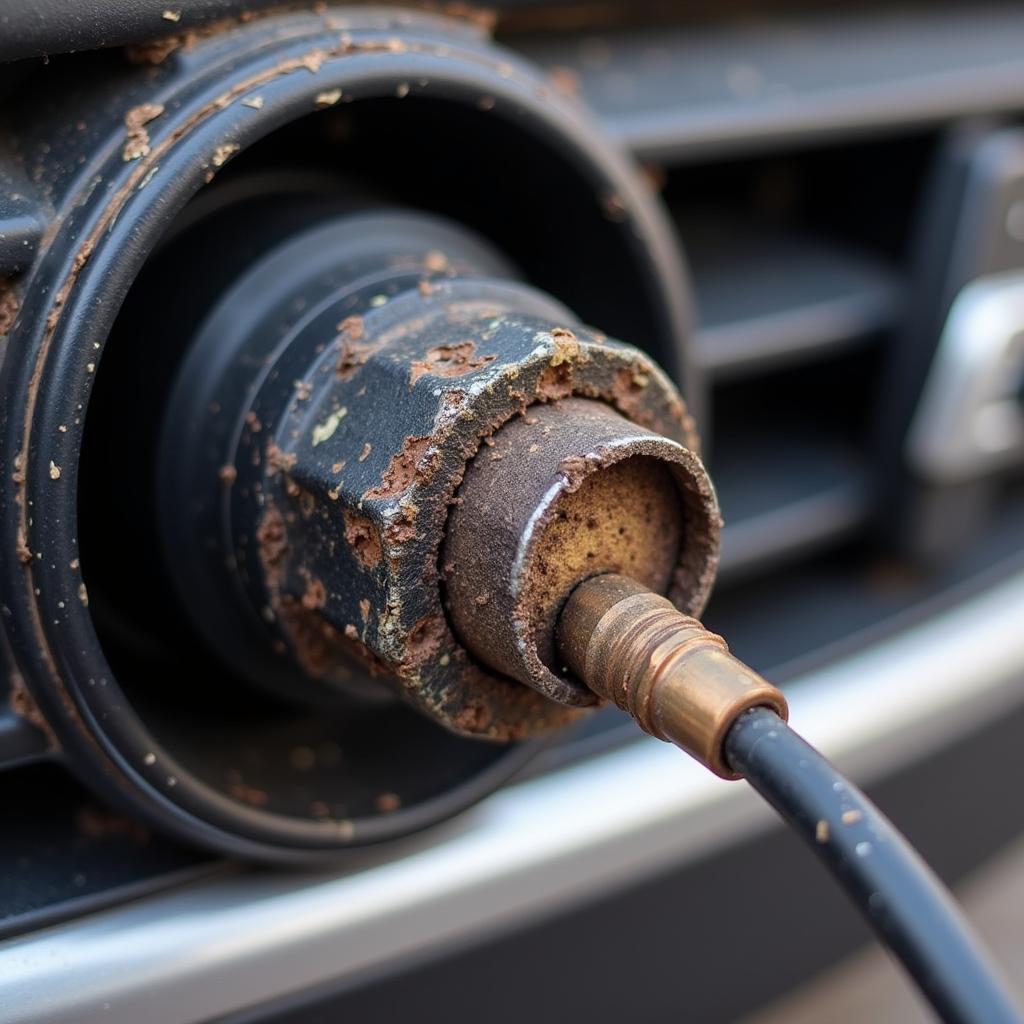Knowing the outside temperature is crucial for safe and comfortable driving. A malfunctioning outside temperature gauge can be annoying and even dangerous, especially in extreme weather conditions. So, how do you fix an outside temperature gauge in your car? This guide will walk you through the common causes and solutions, empowering you to diagnose and potentially fix the problem yourself.
Common Reasons Your Car’s Outside Temperature Gauge is Wrong
There are several reasons why your car’s outside temperature gauge might be displaying incorrect readings. These range from simple fixes to more complex electrical issues. Identifying the root cause is the first step towards a solution.
Faulty Ambient Temperature Sensor
The most common culprit is a faulty ambient temperature sensor. This small sensor, usually located behind the front grill or near the front bumper, is responsible for measuring the outside air temperature. Over time, it can be damaged by debris, corrosion, or simply wear and tear.
 Faulty Ambient Temperature Sensor in Car
Faulty Ambient Temperature Sensor in Car
Wiring Problems
Sometimes, the problem isn’t the sensor itself, but the wiring connecting it to the car’s computer. A loose connection, a broken wire, or corrosion in the connector can disrupt the signal, leading to inaccurate readings or no reading at all.
Damaged Sensor Connector
The connector that attaches the sensor to the wiring harness can also become damaged. This can be caused by corrosion, impact, or simply age. A damaged connector can prevent the sensor from communicating with the car’s computer.
Faulty Instrument Cluster
In some cases, the problem lies within the instrument cluster itself. A malfunctioning gauge or a problem with the cluster’s circuitry can cause incorrect temperature readings. This is less common than a sensor issue, but it’s still a possibility.
How to Fix Outside Temperature Gauge in Car: A Step-by-Step Guide
Now that we’ve identified the potential problems, let’s explore how to address them.
-
Locate the Ambient Temperature Sensor: Consult your car’s owner’s manual for the exact location. It’s typically behind the front grill or near the front bumper.
-
Inspect the Sensor and Wiring: Look for any visible damage to the sensor, such as cracks, corrosion, or debris. Check the wiring for loose connections, breaks, or corrosion.
-
Clean the Sensor: Use a can of compressed air or a soft brush to clean any dirt or debris from the sensor. This simple step can sometimes resolve the issue.
-
Check the Connector: Carefully disconnect the sensor’s electrical connector and inspect it for damage. Look for bent or corroded pins. Clean the connector with electrical contact cleaner if necessary.
-
Test the Sensor: Use a multimeter to test the sensor’s resistance. Compare your readings to the specifications in your car’s repair manual. A faulty sensor will usually have a resistance outside the specified range.
-
Replace the Sensor: If the sensor is faulty, replace it with a new one. This is a relatively simple and inexpensive repair that you can often do yourself.
-
Check the Wiring: If the sensor and connector appear to be fine, check the wiring for continuity using a multimeter. Repair any broken or damaged wires.
-
Consult a Professional: If you’re not comfortable working with electrical systems, or if you’ve tried all the above steps and the problem persists, it’s best to consult a qualified automotive technician. They have the tools and expertise to diagnose and repair more complex issues.
Expert Insights
“A common mistake people make is assuming the entire instrument cluster is faulty when the outside temperature gauge malfunctions,” says John Miller, a seasoned automotive electrical systems expert. “More often than not, it’s a simple fix like a bad sensor or a loose connection.”
Another expert, Susan Davis, an automotive engineer with over 20 years of experience adds, “Regularly inspecting and cleaning the ambient temperature sensor can prevent many issues down the road. It’s a small part that plays a big role in your driving experience.”
Conclusion
Fixing an outside temperature gauge in your car doesn’t always require a trip to the mechanic. By following these steps, you can often diagnose and resolve the issue yourself, saving you time and money. However, if the problem persists, don’t hesitate to contact a qualified automotive technician for assistance. For personalized assistance, connect with the experts at AutoTipPro at +1 (641) 206-8880 or visit our office at 500 N St Mary’s St, San Antonio, TX 78205, United States. We’re here to help you keep your car running smoothly and safely.
FAQ
-
How accurate is the outside temperature gauge in a car? While designed to be reasonably accurate, car temperature gauges can be affected by factors like direct sunlight or engine heat, leading to slight variations from the actual temperature.
-
Can a bad outside temperature gauge affect my car’s performance? While it won’t directly impact engine performance, an inaccurate gauge can hinder your ability to make informed decisions regarding climate control, potentially affecting comfort and fuel efficiency.
-
Where can I buy a replacement ambient temperature sensor? Auto parts stores, online retailers, and dealerships are good sources for replacement sensors.
-
How long does it take to replace an ambient temperature sensor? Replacing the sensor is a relatively quick process, usually taking less than an hour, even for beginners.
-
What tools do I need to replace the sensor? Basic hand tools, such as a screwdriver and pliers, are usually sufficient.
-
What is the average cost of a replacement ambient temperature sensor? The cost varies depending on the car model, but sensors typically range from $15 to $50.
-
Can I drive my car with a broken outside temperature gauge? Yes, you can still drive, but you’ll be without this important piece of information, potentially affecting your comfort and preparedness for weather changes.





Leave a Reply